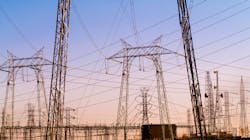California Governor Signs Emergency Proclamation to Expedite Clean Energy Projects
In the face of extreme climate impacts across the West, California Governor Gavin Newsom recently outlined the state's goals to achieve a 100% clean electricity system that supports long-term clean energy reliability. The governor also signed an emergency proclamation to free up energy supply to meet demand during extreme heat events and wildfires that are becoming more intense and to expedite deployment of clean energy resources this year and next year.
“California leads the nation with its ambitious clean energy goals, and with the climate crisis threatening communities across the West, we must take decisive action to scale up and speed up our transition to a 100% clean electricity system that meets the needs of the 22nd century and beyond,” said Newsom. “While we build toward a safe, affordable, and reliable energy future that benefits all our communities, we’re also taking action to meet the challenges caused by climate change that are already at our doorstep.”
Newsom's vision for the electricity system of the future will help take on the climate change impacts being felt in California and throughout the West, including extreme heat waves, drought, and wildfires — which are becoming more frequent and intense, straining the electric grid.
The California Comeback Plan’s roadmap to clean energy includes:
- Increasing the diversity of California's clean energy, including solar, battery storage, onshore and offshore wind, geothermal, pumped storage, and so forth.
- Modernizing the grid and incorporating distributed energy resources (DERs).
- Increasing long-duration energy storage projects.
- Grid hardening and resilience to make transmission and distribution lines more fire resistant, increasing undergrounding of lines, better detection of faults, and the strategic placement of remote grids in vulnerable communities.
- Reducing carbon emissions through electrification of transportation systems, homes, and businesses in the state.
As California works toward a 100% clean electricity system, Newsom is taking action through an emergency proclamation to safeguard the state’s energy system this summer by launching contingency programs that will reduce demand and increase supply, and to expedite clean energy projects to meet the challenge of the rapid acceleration of intensity and duration of record-breaking temperatures and severe drought conditions across the West that threaten California's energy supply and limit the state’s ability to import additional energy. The action comes amid unprecedented climate change impacts being experienced throughout the United States and around the globe, and better positions the state to meet potential extreme heat, drought, and fire impacts next year.
The proclamation suspends certain permitting requirements to allow greater energy production and creates incentives so that large energy users can move to backup power generation, freeing up energy capacity on the grid for everyone else, during critical times when extreme heat events or the interruption of transmission lines from wildfires or other causes threaten energy supply this summer. The proclamation also provides for mitigation to offset impacts from any additional emissions and commits state agencies to tracking emissions from any emergency measures requiring additional emissions.
The proclamation includes actions to accelerate the state’s transition to clean electricity by streamlining permitting and other processes to bring new resources on-line as fast as possible this summer and by next summer, particularly battery storage projects to capture abundant renewable generation available during the day. This rapid procurement and deployment of clean energy production will help end the vicious cycle in which generating energy contributes to the very climate-impact emergencies that threaten energy supply.
California has made tremendous strides toward realizing the electricity system of the future.
- California met its interim target of 33% of electricity from renewable sources by 2020, two years ahead of schedule.
- When the percentage of renewables is combined with other sources of carbon-free energy, such as large hydroelectric generation and nuclear power, the total percentage of clean energy is 63%.
- During the afternoon of April 24, 2021, the state’s renewable generation hit a new all-time high, with 94% of California’s electricity coming from solar, wind, and other clean energy sources.
- In May 2021, California announced a historic agreement with the federal government to advance offshore wind along the California coast.
- California has mandated that all new car and delivery and short-haul truck sales will be zero emission by 2035, and all big-rig truck sales 100% zero emission by 2045.
- California is exploring pathways to achieve carbon neutrality by 2035.
The state budget includes US$812 million over two years to accelerate California’s progress on meeting its clean energy goals and better position California as a leader in advancing clean technologies and as a key partner to the federal administration in tackling climate change and stimulating the economy. This includes a US$735-million General Fund over two years, pursuant to subsequent legislation, which the administration has proposed investing in pre-commercial long-duration storage projects that are critical to the success of California’s efforts to decarbonize the electricity system, energy efficiency in the industrial sector, reducing energy use at food production facilities, and green hydrogen production.
The text of the proclamation can be found here.
